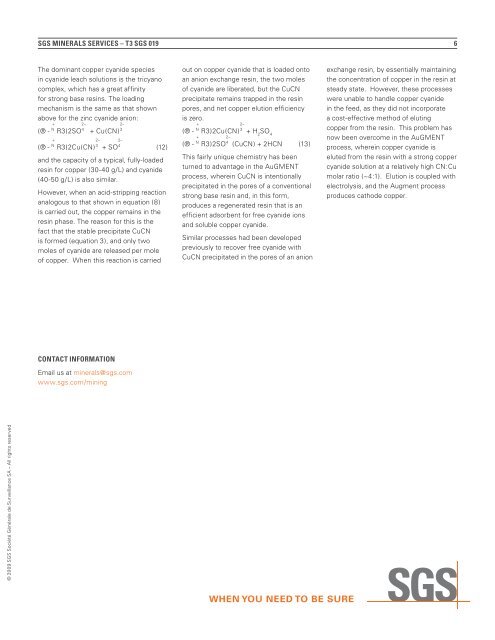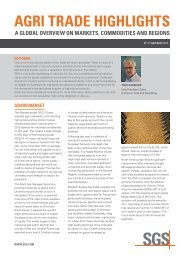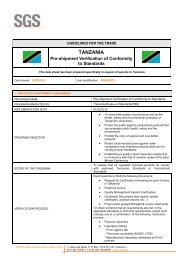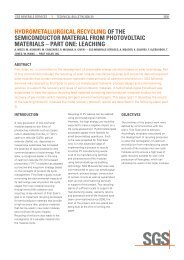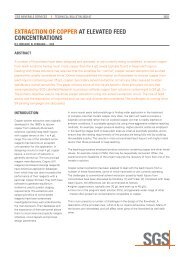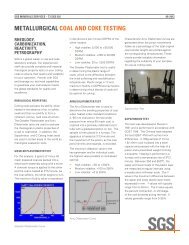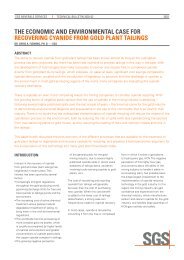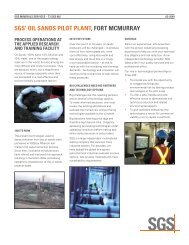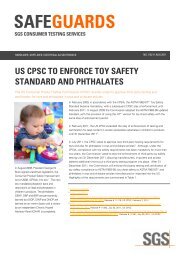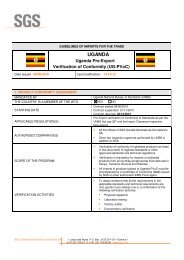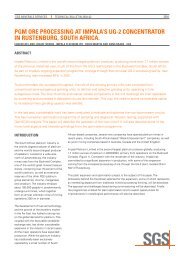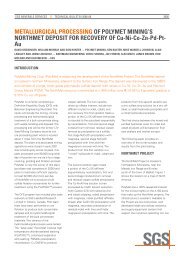Create successful ePaper yourself
Turn your PDF publications into a flip-book with our unique Google optimized e-Paper software.
© 2009 <strong>SGS</strong> Société Générale de Surveillance SA – All rights reserved<br />
<strong>SGS</strong> MINERALS SERVICES – T3 <strong>SGS</strong> 019 6<br />
The dominant copper cyanide species<br />
in cyanide leach solutions is the tricyano<br />
complex, which has a great affinity<br />
for strong base resins. The loading<br />
mechanism is the same as that shown<br />
above for the zinc cyanide anion:<br />
(® - N<br />
+<br />
R3)2SO4 2–<br />
2–<br />
+ Cu(CN) 3<br />
(® - N<br />
+<br />
R3)2Cu(CN) 3<br />
2–<br />
+ SO4 2–<br />
⇔<br />
(12)<br />
and the capacity of a typical, fully-loaded<br />
resin for copper (30-40 g/L) and cyanide<br />
(40-50 g/L) is also similar.<br />
However, when an acid-stripping reaction<br />
analogous to that shown in equation (8)<br />
is carried out, the copper remains in the<br />
resin phase. The reason for this is the<br />
fact that the stable precipitate CuCN<br />
is formed (equation 3), and only two<br />
moles of cyanide are released per mole<br />
of copper. When this reaction is carried<br />
CONTACT INFORMATION<br />
Email us at minerals@sgs.com<br />
www.sgs.com/mining<br />
out on copper cyanide that is loaded onto<br />
an anion exchange resin, the two moles<br />
of cyanide are liberated, but the CuCN<br />
precipitate remains trapped in the resin<br />
pores, and net copper elution efficiency<br />
is zero.<br />
(® - N<br />
(® - N<br />
+<br />
R3)2Cu(CN) 3<br />
2–<br />
+<br />
R3)2SO4 2–<br />
+ H 2 SO 4 ⇔<br />
(CuCN) + 2HCN (13)<br />
This fairly unique chemistry has been<br />
turned to advantage in the AuGMENT<br />
process, wherein CuCN is intentionally<br />
precipitated in the pores of a conventional<br />
strong base resin and, in this form,<br />
produces a regenerated resin that is an<br />
efficient adsorbent for free cyanide ions<br />
and soluble copper cyanide.<br />
Similar processes had been developed<br />
previously to recover free cyanide with<br />
CuCN precipitated in the pores of an anion<br />
exchange resin, by essentially maintaining<br />
the concentration of copper in the resin at<br />
steady state. However, these processes<br />
were unable to handle copper cyanide<br />
in the feed, as they did not incorporate<br />
a cost-effective method of eluting<br />
copper from the resin. This problem has<br />
now been overcome in the AuGMENT<br />
process, wherein copper cyanide is<br />
eluted from the resin with a strong copper<br />
cyanide solution at a relatively high CN:Cu<br />
molar ratio (~4:1). Elution is coupled with<br />
electrolysis, and the Augment process<br />
produces cathode copper.


